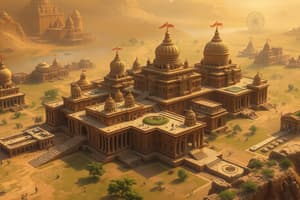Podcast
Questions and Answers
What was another name for the Indus Valley Civilization?
What was another name for the Indus Valley Civilization?
Harappan Civilization
During which time period did the Indus Valley Civilization thrive?
During which time period did the Indus Valley Civilization thrive?
approximately 7000 to 600 BCE
Where was the Indus Valley Civilization located geographically?
Where was the Indus Valley Civilization located geographically?
in the valley of the Indus River
What characterized the cities of the Indus Valley Civilization?
What characterized the cities of the Indus Valley Civilization?
How extensive was the geographical area covered by the Indus Valley Civilization?
How extensive was the geographical area covered by the Indus Valley Civilization?
What were some key features of the cities in the Indus Valley Civilization?
What were some key features of the cities in the Indus Valley Civilization?
What were two notable cities of the Indus Valley Civilization and where were they located?
What were two notable cities of the Indus Valley Civilization and where were they located?
What were some key cultural innovations of the Indus Valley Civilization?
What were some key cultural innovations of the Indus Valley Civilization?
What were some crops cultivated by the inhabitants of the Indus Valley Civilization?
What were some crops cultivated by the inhabitants of the Indus Valley Civilization?
What clues hint at varying degrees of social stratification in the Indus Valley Civilization?
What clues hint at varying degrees of social stratification in the Indus Valley Civilization?
What are some theories proposed to explain the decline of the Indus Valley Civilization?
What are some theories proposed to explain the decline of the Indus Valley Civilization?
What are some characteristics that define the Indus Valley Civilization?
What are some characteristics that define the Indus Valley Civilization?
Study Notes
The Indus Valley Civilization: An Ancient Cityscape
The Indus Valley Civilization, also known as the Harappan Civilization, was a significant urban culture that thrived in the northern region of the Indian subcontinent between approximately 7000 and 600 BCE. This civilization, located in the valley of the Indus River, is characterized by its impressive urban planning, monumental architecture, and advanced engineering solutions.
Geographical Extent
The Indus Valley Civilization extended from modern-day northeast Afghanistan to Pakistan and northwest India. It was one of the world's earliest urban civilizations, covering an expansive area along the banks of the Indus River and beyond. Excavations of Indus Valley sites have revealed settlements as far apart as Sutkagen Dor in southwestern Balochistan province, Pakistan, near the shores of the Arabian Sea, and Ropar in eastern Punjab state, northwestern India. The civilization spanned over 900 miles (1,500 km), making it one of the most extensive ancient civilizations.
Urban Planning and Architecture
The cities of the Indus Valley Civilization were known for their meticulous planning and engineering sophistication. They featured wide streets, well-organized drainage systems, water supply systems, and clusters of large non-residential buildings such as granaries and warehouses. Notable examples include Harappa and Mohenjo-daro, both located in modern-day Pakistan and estimated to have accommodated populations between 40,000-50,000 people. These two cities typically had dimensions around 1 mile (1.6 km) square, suggesting centralized political control through either two large states or a single great empire with alternative capitals.
Cultural Innovations
One of the key features of the Indus Valley Civilization is its standardized weights and measures, which indicate a strong degree of political and administrative control over a vast region. Additionally, the civilization boasted a sophisticated drainage system, suggesting that the residents were well-versed in managing water resources. The inhabitants also practiced irrigated agriculture, cultivating crops like wheat, barley, and legumes. Domestic animals such as humped cattle, shorthorn cattle, and dogs were part of their livestock.
Social Structure and Political System
Despite extensive archaeological research, much remains uncertain regarding the social structure and political organization of the Indus Valley Civilization. However, clues like differences in house sizes and craft specialization hint at varying degrees of social stratification. Trade was extensive and well-regulated, possibly involving the establishment of Harappan "colonies" in Mesopotamia and Badakhshan. The uniformity of weights and measures throughout the Indus lands suggests a strong centralized authority or an empire with multiple capitals.
Decline and End of the Civilization
The reasons for the decline and end of the Indus Valley Civilization between 1900 and 1500 BCE are still unclear. Some theories include climate change, the drying up of the Sarasvati River, alteration in monsoon patterns that affected crop growth, population pressure on urban areas, trade disruption with Egypt and Mesopotamia, or a combination of these factors. However, no definitive evidence has been found to support any one theory.
In summary, the Indus Valley Civilization represents an early chapter in human history characterized by advancements in urban planning, agriculture, and engineering. While much remains unknown about this civilization, ongoing research continues to shed light on its achievements and challenges, offering insights into the evolution of human societies over time.
Studying That Suits You
Use AI to generate personalized quizzes and flashcards to suit your learning preferences.
Description
Test your knowledge about the urban culture of the Indus Valley Civilization, including its urban planning, architecture, cultural innovations, social structure, and decline. Explore the historical significance and advancements of this ancient civilization in the Indian subcontinent.




